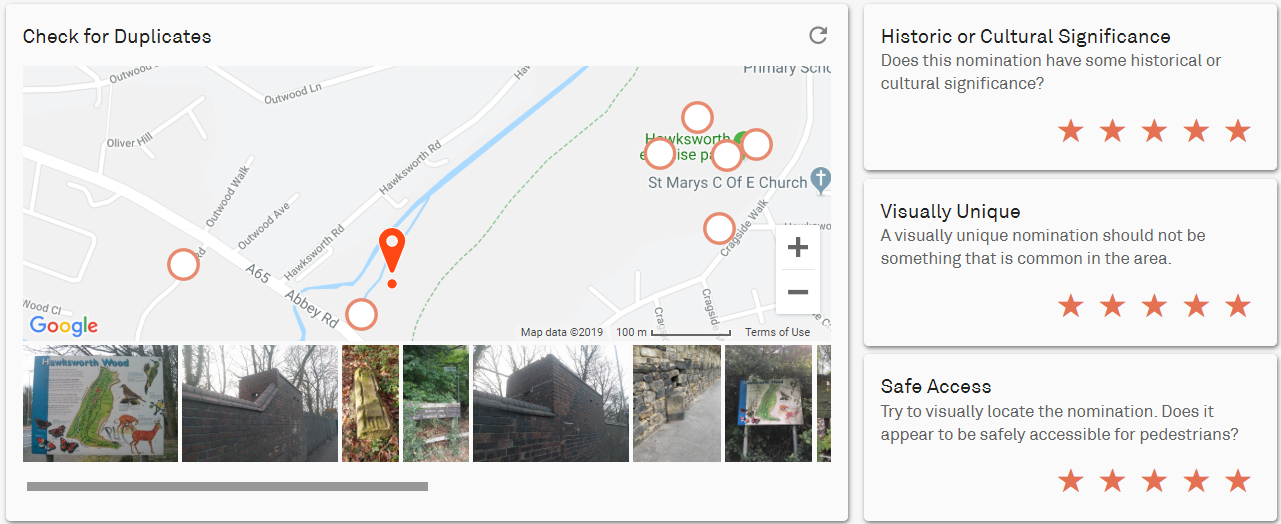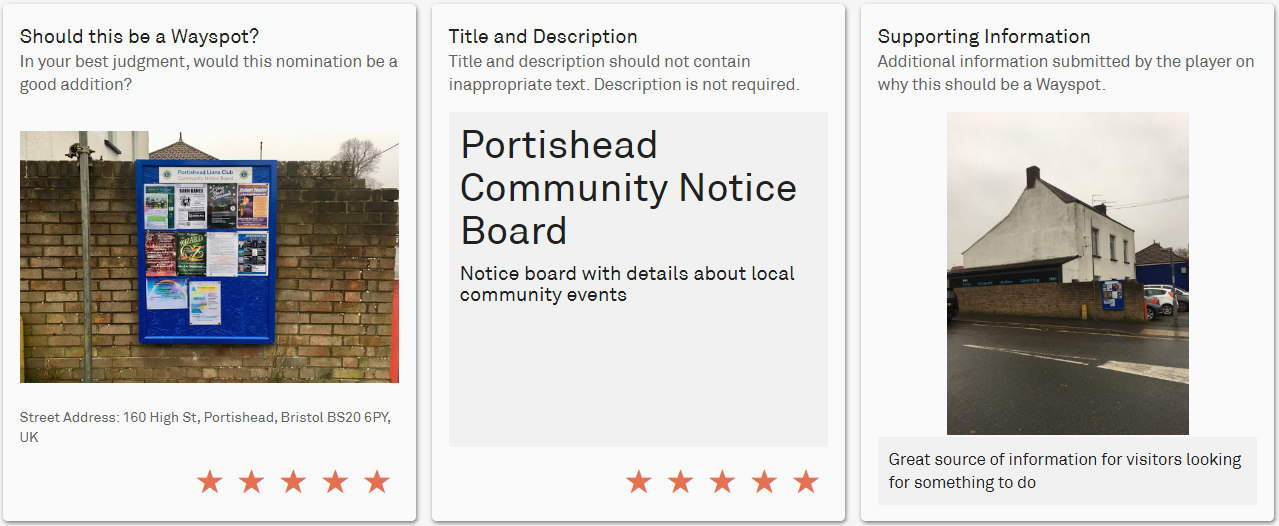
I recently wrote about a new feature available to level 40 Pokémon GO players and Niantic‘s replacement to Operation Portal recon (OPR), Niantic Wayfarer.
One of the things that seems to be frustrating many newcomers to Niantic Wayfarer is how the Wayspot approval process works and how to prevent themselves from falling “into the red” when it comes to their own rating as Wayfarers.
As such, this post is most likely to only be of interest to Pokémon GO players or Ingressers that are new to the Niantic Wayfarer programme.
My aim here is to give an overview of the Niantic Wayfarer programme and how to effectively review wayspot submissions. This is all my own opinion and may differ to the opinion of other Wayfarers.
What is Niantic Wayfarer?
Niantic Wayfarer is a tool by which Niantic farm out the rating and approval or rejection of points of interest (POI) submitted to the global POI database that sits behind their popular augmented reality games: Ingress, Pokémon GO and Harry Potter: Wizards Unite.
Any Ingress player that has reached level 10 (of 16) or Pokémon GO player who has reached the level cap (level 40) can register for access. Once in, players can manage their own POI submissions (Niantic call these Wayspots) and also rate submissions made by other players.
Once a player has registered to join the programme, they then have to pass a test before they can continue.
Why do I have to pass a test?
Niantic have strict criteria as to the POI that they will accept within their global POI database. There are rules in place to ensure the safety and security of the general public as well as players and there are rules in place to ensure a certain quality of POI.
Niantic’s overall goal with their GPS based games is to inspire players to get out and discover the world about them – the POI in their games are intended to be hooks to attract players to do just that.

The test to gain access to Niantic Wayfarer is kind of like a combination of a tutorial in what makes a good wayspot with an exam to ensure that the end user understands that.
Reviewers are continually assessed by comparing their responses to those of the community as a whole.
If your ratings are in line with the majority of the community then you’re personal rating stays in the green; if you find yourself at odds with the community, you’ll slip into the yellow and then the red.
Reviewers with a green rating have a heavier weighting than reviewers in the red or yellow.
How should I be rating wayspots?
Well, that’s a good question.
Niantic have published guidelines on what makes a good wayspot but the guidelines alone aren’t enough to make sure you’re rating things effectively.
The first rule when reviewing wayspot submissions is this: don’t rush.
Yes, the screen can timeout after several minutes but you still get enough time to analyse the submission and pass judgement. If you rush through ticking 5 stars to everything, you’ll end up approving some thoroughly awful submissions. Likewise, think twice before rejecting something.
I used to blanket reject the red UK post boxes and playing fields but it turns out that some of them are perfectly valid candidates, worthy of approval.

Don’t be tempted to power through quickly, Niantic have built a speed bump into the process and you could find yourself locked out for 24 hours as happened to a member of our local community (Thanks AG).
Take time to check for duplicates, check the location is correct and check that the postbox is a valid King George or Genuine King Edward or Queen Victoria one and not an EIIR one.
The second rule when reviewing is kind of like the first: take time to look at every angle.
Does the wayspot actually exist where it says it does? Most submissions now require that the player submits a photograph that shows the surrounding area of the submission is safe to play in. This photo should match up with Google maps and Street View in some regard.
I’ve lost count of the number of submissions that I have rejected because the POI had been flagged outside somebody’s house rather than where it actually existed.
Is the wayspot blocking access to an emergency service or is it close to a school? Quite often you may click an acceptance on a wayspot that others have rejected because of this and that will mark you down on your personal rating.
The third and final rule: Don’t fall for sob stories.
The rest of the Wayfarer community couldn’t care less that there are no Gyms or stops in a particular cell. Old school Ingressers are unlikely to care that the player submitting a candidate needs one more stop to trigger a gym in the area. All they care about is the validity of the wayspot candidate. Don’t be tempted to let a poor candidate through because there are no other wayspots around.
But how do you do it Armaitus?
Another good question and one that isn’t as easily answered. I was going to try to record a video of myself running through some wayspot nominations but I chose to screenshot a few examples instead.
Example 1, a rejection.

This looks almost legitimate. I’m not too keen on the submission being an empty field but it is a place of local interest.
I then check the next section, checking for duplicates.

Here, we see that the suggested POI is already present, albeit in the form of a sign identifying the complex. That renders this submission just a field… the actual POI is already flagged.

Therefore, the answer (my answer) was to mark with 1 star and set it as an ineligible wayspot nomination. Note that I also take the time to explain my reasoning.
Example 2, an EIIR Postbox.

All postboxes are royal in the UK but not all are eligible wayspots in Wayfarer. Queen Elizabeth II postboxes are deemed too modern to be eligible; Postboxes from the reigns of Queen Victoria, King Edward VII, King George V, King Edward VIII or King George VI are fair game.
The way to check is to look at the wayspot image for a royal cipher, in this case:

Definitely from the reign of Queen Elizabeth II and so…

… give it 1 star and reject it.
Example 3, it’s OK to be unsure.
You don’t have to 1 or 5 star everything. In fact Niantic encourage you to use a wide range of star ratings dependent on specific criteria. There’s a Google Doc that maintains current guidance for the UK. This has tabs explaining what star rating fits certain criteria.
To be honest, that’s too deep a level for me, I like to go with my gut on these things.

In this example we see a rather uninspiring photo with very little to it. The title and description indicate that it could be a valid wayspot candidate. A historic POI on a woodland trail, all good. I just have a niggle, is it really what it says it is?
Well, its a good story so I won’t just dismiss it.

It’s historic, visually unique and safely accessed.

I can’t guarantee that it is in the right place though.
So I rated 3 stars overall, I think it should be a wayspot but have a doubt. Note that I’ve also filled in the optional “What is it?” bit, in the hopes that Niantic see my reasoning.
Example 4, one I might have rejected on first glance.

Traditionally, road signs are a 1-star rejection. This isn’t any old road sign though.
On second glance after reading the description and supporting information, this is an art installation of sorts. Unique art signs marking a trail. Exactly the kind of thing Niantic are after.
So after checking for duplicates and safety it gets a 5 star thumbs up from me.

I’d like to add that I questioned the anonymity of submissions at this point. A local walker has taken a 360 degree photo of the sign in the past. I know this particular photographer and he didn’t submit the wayspot.
Example 5, grist for the mill.
And now we get to the final example for this post. This example is pretty much par for the course, certainly for UK towns and villages… the village notice board. It’s not pretty, it’s fairly generic but it is a valid candidate.



I 5-starred the location accuracy and updated the “What is it?” information.
There you have it, a glance into the mind of an infrequent Niantic Wayfarer reviewer. I may get round to recording a video of a review session but there are plenty to view on YouTube already.



















 After a couple of months of waiting,
After a couple of months of waiting, 
 Th
Th


 The battle is pretty much as you’d expect. You fight the boss as usual. In the long run, Niantic plan on restricting the damage done by remote raiders but for now they have “boosted” your damage to negate that affect.
The battle is pretty much as you’d expect. You fight the boss as usual. In the long run, Niantic plan on restricting the damage done by remote raiders but for now they have “boosted” your damage to negate that affect.






















 Here you can see that I have put a great deal of effort into my own submission. Paying little or no attention to spelling or content.
Here you can see that I have put a great deal of effort into my own submission. Paying little or no attention to spelling or content.
